cplex中文教程
- 格式:pdf
- 大小:644.74 KB
- 文档页数:3
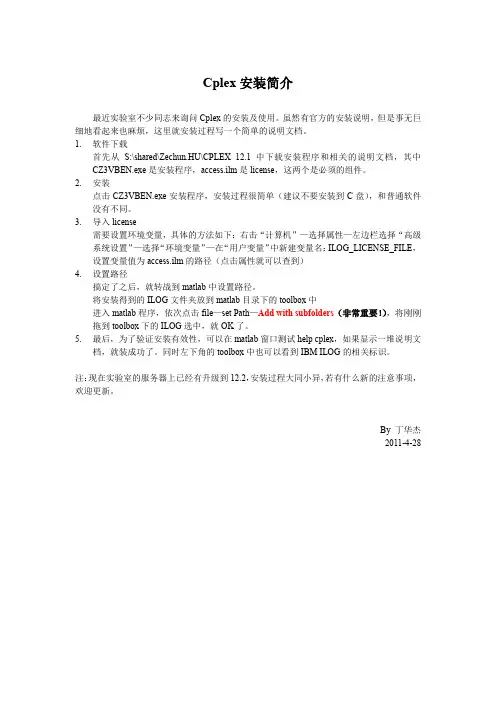
Cplex安装简介
最近实验室不少同志来询问Cplex的安装及使用。
虽然有官方的安装说明,但是事无巨细地看起来也麻烦,这里就安装过程写一个简单的说明文档。
1.软件下载
首先从S:\shared\Zechun.HU\CPLEX 12.1中下载安装程序和相关的说明文档,其中CZ3VBEN.exe是安装程序,access.ilm是license,这两个是必须的组件。
2.安装
点击CZ3VBEN.exe安装程序,安装过程很简单(建议不要安装到C盘),和普通软件没有不同。
3.导入license
需要设置环境变量,具体的方法如下:右击“计算机”—选择属性—左边栏选择“高级系统设置”—选择“环境变量”—在“用户变量”中新建变量名:ILOG_LICENSE_FILE,设置变量值为access.ilm的路径(点击属性就可以查到)
4.设置路径
搞定了之后,就转战到matlab中设置路径。
将安装得到的ILOG文件夹放到matlab目录下的toolbox中
进入matlab程序,依次点击file—set Path—Add with subfolders(非常重要!),将刚刚拖到toolbox下的ILOG选中,就OK了。
5.最后,为了验证安装有效性,可以在matlab窗口测试help cplex,如果显示一堆说明文
档,就装成功了。
同时左下角的toolbox中也可以看到IBM ILOG的相关标识。
注:现在实验室的服务器上已经有升级到12.2,安装过程大同小异,若有什么新的注意事项,欢迎更新。
By 丁华杰
2011-4-28。
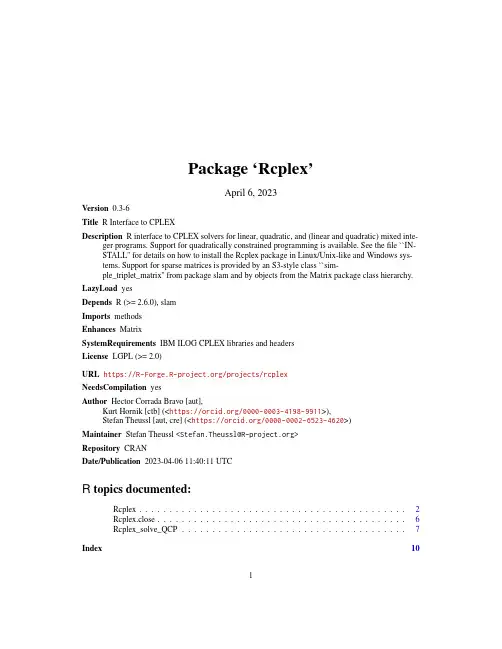
Package‘Rcplex’April6,2023Version0.3-6Title R Interface to CPLEXDescription R interface to CPLEX solvers for linear,quadratic,and(linear and quadratic)mixed inte-ger programs.Support for quadratically constrained programming is available.See thefile``IN-STALL''for details on how to install the Rcplex package in Linux/Unix-like and Windows sys-tems.Support for sparse matrices is provided by an S3-style class``sim-ple_triplet_matrix''from package slam and by objects from the Matrix package class hierarchy. LazyLoad yesDepends R(>=2.6.0),slamImports methodsEnhances MatrixSystemRequirements IBM ILOG CPLEX libraries and headersLicense LGPL(>=2.0)URL https:///projects/rcplexNeedsCompilation yesAuthor Hector Corrada Bravo[aut],Kurt Hornik[ctb](<https:///0000-0003-4198-9911>),Stefan Theussl[aut,cre](<https:///0000-0002-6523-4620>)Maintainer Stefan Theussl<****************************>Repository CRANDate/Publication2023-04-0611:40:11UTCR topics documented:Rcplex (2)Rcplex.close (6)Rcplex_solve_QCP (7)Index101Rcplex Solve optimization problem with CPLEXDescriptionInterface to CPLEX solvers for linear quadratic and(linear or quadratic)mixed-integer programs.The general statement of the problem ismin 12x Qx+c xs.t Ax≤blb≤x≤ubIf Q==NULL then the problem is linear,if any value of the vtype argument is"B"or"I"then the prob-lem is a mixed-integer program.The control argument is used to set CPLEX’s many parameters.See details.The objsense determines if the problem is a maximization or minimization problem.The sense argument is used to set the constraint directions.UsageRcplex(cvec,Amat,bvec,Qmat=NULL,lb=0,ub=Inf,control=list(),objsense=c("min","max"),sense="L",vtype=NULL,n=1)Argumentscvec The linear coefficient of the objective functionAmat The constraint matrix(requires ncol(Amat)==length(cvec))bvec The constraints right-hand side(requires length(bvec)==nrow(Amat))Qmat The quadratic coefficient of the objective function.If NULL the problem is lin-ear.If not NULL,it must be a symmetric positive semidefinite matrix of sizelength(cvec)by length(cvec).Default NULLlb Lower bound on the problem variables.If length(lb)==1then lb is the lowerbound of all variables.Otherwise,length(lb)==length(cvec).Set lb=-Infto have no lower bound.Default0.ub Upper bound on the problem variables.See lb for further details.Default Inf.control A list of CPLEX parameters.See*Details*objsense Either"max"or"min",determines the optimization direction.Default"min"sense The direction of the inequality in each constraint.If length(sense)==1then thesame value is taken for each constraint.Can be one of"L"(less than or equal),"G"(reater than or equal)or"E"(equal).Requires length(sense)==length(bvec).Default"L".vtype Determines the type of each problem variable.Can be one of"C"(continuous), "I"(integer)or"B"(binary).If length(vtype)==1the same value is taken forall variables.Otherwise,requires length(vtype)==length(ctype).Default"C".n Determines the maximal number of solutions the solver should return in case of an MIP with more than one solution at optimum.If CPLEX should searchfor"all"solutions then n has to be set to NA.In CPLEX this is also calledpopulating the solution pool.The parameters solnpoolagap,solnpoolgap,and solnpoolintensity influence the search for multiple solutions(see alsothe control argument below for details).Available from CPLEX11.0on.Rcplex()raises a warning if an older version of CPLEX is used and n>1.De-fault1.DetailsMatrices A and C may be sparse matrices from a class in the hierarchy defined by the Matrix pack-age.In that case,the internal casting functions are used to create the proper data structures to pass to CPLEX,which is similar to the column-major storage mode defined by the dgCMatrix-class defined by the Matrix package.We also provide a simple S3-style class for sparse matrices simple_triplet_matrix,as used in the relations package.Matrices A and C can be objects of this class.See the examples for example usage.simple_triplet_matrix objects MUST be in column-major order.The control argument can be used to set CPLEX’s many parameters,including the particular algorithm used for solving the given problem.See the ILOG CPLEX Parameters guide for further details.The following parameters are supported:trace:Turn CPLEX output on(1)or off(0).Default1.maxcalls:Number of calls to the CPLEX optimizer before license is released.Set to1to get a new license on every call to Rcplex.Can be any positive number.Default500.method:Algorithm to use(Default0):0:Automatic:CPLEX chooses algorithm automatically1:Primal Simplex2:Dual Simplex3:Network Simplex4:Barrierpreind:Turn presolver on(1)or off(0).Default1.aggind:Limit on the number of applications of the aggregator.Possible Values:-1(automatic),0 (do not use),any positive integeritlim:Maximum number of simplex iterations.Can be any nonnegative number.Default1e8.epagap:Absolute MIP optimality gap tolerance.Can be any nonnegative number.Default1e-6.epgap:Relative MIP optimality gap tolerance.Can be any nonnegative number.Default1e-4.tilim:Time limit in seconds of call to optimizer.Can be any nonnegative number.Default1e75.disjcuts:Indicator for disjunctive cuts used in MIP solver.Must be in-1:3.Default0(automatic).mipemphasis:Indicator for MIP solver emphasis.Must be in0:4.Default0(balance optimality and feasibility)cliques:Indicator for clique cuts in MIP solver.Must be in-1:2.Default0(automatic)nodesel:Node selection strategy in MIP solver.Must be in0:3.Default1(best-bound search).probe:Probe level in MPI solver.Must be-1:3.Default0(automatic)varsel:Variable selection strategy in MIP solver.Must be in-1:4.Default0(choose best method automatically).flowcovers:Indicator forflowcover cuts in MIP solver.Must be in-1:2.Default0(automatic).solnpoolagap:Sets an absolute tolerance on the objective value for the solutions in the solution pool.Can be any nonnegative real number.Ignored in versions<11.0of CPLEX.Default0 solnpoolgap:Sets a relative tolerance on the objective value for the solutions in the solution pool.Can be any nonnegative real number.Ignored in versions<11.0of CPLEX.Default0 solnpoolintensity:Controls the trade-off between the number of solutions generated for the solu-tion pool and the amount of time and memory consumed.Must be in0:4.Ignored in versions<11.0of CPLEX.Default0(automatic).round:Flag indicating if integer solutions for MIPs should be rounded before returning.In some cases,CPLEX returns slightly infeasible integer solutions.Setting this option to1ensures that the returned solution is integral by rounding.Default0(no rounding).ValueReturns a list with the following components,or,if n>1a list of length equal to the number of optimal solutions containing the following components for each solution:xopt Values of problem variables at optimum.obj Value of objective function at optimum.status Solution status.See CPLEX documentation for meaning of status codes.extra List with extra information about solution with componentsslack:Values of slack variables for inequality constraints.nodecnt:(IF MIP PROBLEM)Number of nodes in the search tree evaluatedlambda:(IF NOT MIP PROBLEM)Values of dual variables at optimumAuthor(s)Hector Corrada Bravo and Stefan TheusslReferencesIBM ILOG CPLEX Optimization Studio documentationSee AlsoRcplex.close,optimExamples##A linear program(this is lpex1.c in the CPLEX examples)cvec<-c(1,2,3)Amat<-matrix(c(-1,1,1,-1,3,-1),byrow=TRUE,nc=3)bvec<-c(20,-30)ub<-c(40,Inf,Inf)res<-Rcplex(cvec,Amat,bvec,ub=ub,objsense="max",sense=c( L , G )) print(res)##A linear program with random data##use the barrier methodn=20;m=25nnz<-trunc(.2*m*n)##entries in simple_triplet_matrix clas##*must*be in column major ordernnz<-sort(sample(m*n,nnz,replace=FALSE)-1)Amat<-simple_triplet_matrix(i=(nnz%%m)+1,j=trunc(nnz/m)+1,v=rnorm(nnz),nrow=m,ncol=n)x0<-runif(n)b<-as.matrix(Amat)%*%x0cvec<-rnorm(n)res<-Rcplex(cvec,Amat,b,sense= E ,control=list(method=4))print(res)##A quadratic problem(this is qpex1.c in the CPLEX examples)cvec<-c(1,2,3)Qmat<-matrix(c(-33,6,0,6,-22,11.5,0,11.5,-11),byrow=TRUE,nc=3)Amat<-matrix(c(-1,1,1,1,-3,1),byrow=TRUE,nc=3)bvec<-c(20,30)ub<-c(40,Inf,Inf)res<-Rcplex(cvec,Amat,bvec,Qmat,ub=ub,objsense="max")print(res)##A mixed integer linear program(mipex1.c in the CPLEX examples) cvec<-c(1,2,3,1)Amat<-matrix(c(-1,1,1,10,1,-3,1,0,0,1,0,-3.5),6Rcplex.close byrow=TRUE,nc=4)bvec<-c(20,30,0)lb<-c(0,0,0,2)ub<-c(40,Inf,Inf,3)vtype<-c(rep("C",3),"I")res<-Rcplex(cvec,Amat,bvec,lb=lb,ub=ub,sense=c("L","L","E"),objsense="max",vtype=vtype)print(res)##A mixed integer quadratic programcvec<-c(1,2,3,1)Qmat<-matrix(c(-33,6,0,0,6,-22,11.5,0,0,11.5,-11,0,0,0,0,0),byrow=TRUE,nc=4)Amat<-matrix(c(-1,1,1,10,1,-3,1,0,0,1,0,-3.5),byrow=TRUE,nc=4)bvec<-c(20,30,0)ub<-c(40,Inf,Inf,3)vtype<-c(rep("C",3),"I")res<-Rcplex(cvec,Amat,bvec,Qmat=Qmat,ub=ub,sense=c("L","L","E"),objsense="max",vtype=vtype)print(res)Rcplex.close()Rcplex.close Release CPLEX licenseDescriptionThis function releases the currently held CPLEX license.UsageRcplex.close()Author(s)Hector Corrada BravoSee AlsoRcplexRcplex_solve_QCP Solve quadratically constrained optimization problem with CPLEXDescriptionInterface to CPLEX solvers for quadratically constrained linear,quadratic,and mixed-integer pro-grams.The general statement of the problem ismin 12x Qx+c xs.t Ax≤band a i x+x Q i x≤r i fori=1,...,qlb≤x≤ubIf Q==NULL then the problem is linear,if any value of the vtype argument is"B"or"I"then the prob-lem is a mixed-integer program.The control argument is used to set CPLEX’s many parameters.See details.The objsense determines if the problem is a maximization or minimization problem.The sense argument is used to set the constraint directions.UsageRcplex_solve_QCP(cvec,Amat,bvec,Qmat=NULL,QC,lb=0,ub=Inf,sense="L",objsense=c("min","max"),vtype =NULL,n=1,control=list())Argumentscvec The linear coefficient of the objective functionAmat The constraint matrix(requires ncol(Amat)==length(cvec))bvec The constraints right-hand side(requires length(bvec)==nrow(Amat))Qmat The quadratic coefficient of the objective function.If NULL the problem is lin-ear.If not NULL,it must be a symmetric positive semidefinite matrix of sizelength(cvec)by length(cvec).Default NULLQC a list with three elements:QC,dir,and b.The element QC is a list with the quadratic part Q,a matrix,and the linear part of the constraint L,a numeric(currently nonzero values are not supported).dir has the same meaning asargument sense and b as bvec.lb Lower bound on the problem variables.If length(lb)==1then lb is the lower bound of all variables.Otherwise,length(lb)==length(cvec).Set lb=-Infto have no lower bound.Default0.ub Upper bound on the problem variables.See lb for further details.Default Inf.control A list of CPLEX parameters.See*Details*objsense Either"max"or"min",determines the optimization direction.Default"min"sense The direction of the inequality in each constraint.If length(sense)==1then thesame value is taken for each constraint.Can be one of"L"(less than or equal),"G"(reater than or equal)or"E"(equal).Requires length(sense)==length(bvec).Default"L".vtype Determines the type of each problem variable.Can be one of"C"(continuous),"I"(integer)or"B"(binary).If length(vtype)==1the same value is taken forall variables.Otherwise,requires length(vtype)==length(ctype).Default"C".n Determines the maximal number of solutions the solver should return in caseof an MIP with more than one solution at optimum.If CPLEX should searchfor"all"solutions then n has to be set to NA.In CPLEX this is also calledpopulating the solution pool.The parameters solnpoolagap,solnpoolgap,and solnpoolintensity influence the search for multiple solutions(see alsothe control argument below for details).Available from CPLEX11.0on.Rcplex()raises a warning if an older version of CPLEX is used and n>1.De-fault1.DetailsSee function link[Rcplex]{Rcplex}()for more information about sparse matrix representation and control arguments.ValueReturns a list with the following components,or,if n>1a list of length equal to the number of optimal solutions containing the following components for each solution:xopt Values of problem variables at optimum.obj Value of objective function at optimum.status Solution status.See CPLEX documentation for meaning of status codes.extra List with extra information about solution with componentsslack:Values of slack variables for inequality constraints.nodecnt:(IF MIP PROBLEM)Number of nodes in the search tree evaluatedlambda:(IF NOT MIP PROBLEM)Values of dual variables at optimumAuthor(s)Hector Corrada Bravo and Stefan TheusslReferencesIBM ILOG CPLEX Optimization Studio documentationSee AlsoRcplex.close,optimExamples##objective functionc<-c(1,2,3)Q<-matrix(c(-33,6,0,6,-22,11.5,0,11.5,-11),nrow=3)##constraints##linear partA<-matrix(c(-1,1,1,-3,1,1),nrow=2)dir<-c("L","L")b<-c(20,30)##quadratic partQC<-list(QC=list(Q=list(diag(1,nrow=3)),L=NULL),dir="L",b=1)##boundsub<-c(40,Inf,Inf)##solveres<-Rcplex_solve_QCP(c,A,b,Q,ub=ub,QC=QC,sense=dir,objsense="max") print(res)##solve MIQCPres<-Rcplex_solve_QCP(c,A,b,Q,ub=ub,QC=QC,sense=dir,objsense="max",vtype=c("C","I","C")) ##quadratic and linear partQC<-list(QC=list(Q=list(diag(1,nrow=3)),L=list(c(3,4,-3))),dir="L",b=1)##solveres<-Rcplex_solve_QCP(c,A,b,Q,ub=ub,QC=QC,sense=dir,objsense="max") print(res)Rcplex.close()Index∗optimizeRcplex,2Rcplex_solve_QCP,7∗utilitiesRcplex.close,6optim,4,8Rcplex,2,6Rcplex.close,4,6,8Rcplex_solve_QCP,710。
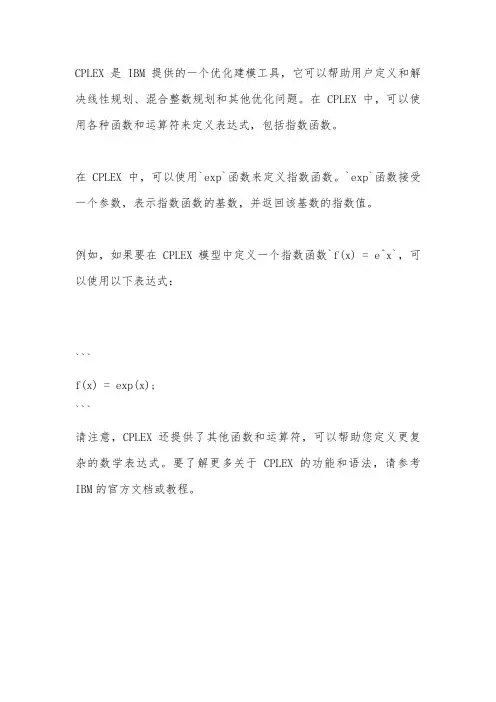
CPLEX是IBM提供的一个优化建模工具,它可以帮助用户定义和解决线性规划、混合整数规划和其他优化问题。
在CPLEX中,可以使用各种函数和运算符来定义表达式,包括指数函数。
在CPLEX中,可以使用`exp`函数来定义指数函数。
`exp`函数接受一个参数,表示指数函数的基数,并返回该基数的指数值。
例如,如果要在CPLEX模型中定义一个指数函数`f(x) = e^x`,可以使用以下表达式:
```
f(x) = exp(x);
```
请注意,CPLEX还提供了其他函数和运算符,可以帮助您定义更复杂的数学表达式。
要了解更多关于CPLEX的功能和语法,请参考IBM的官方文档或教程。
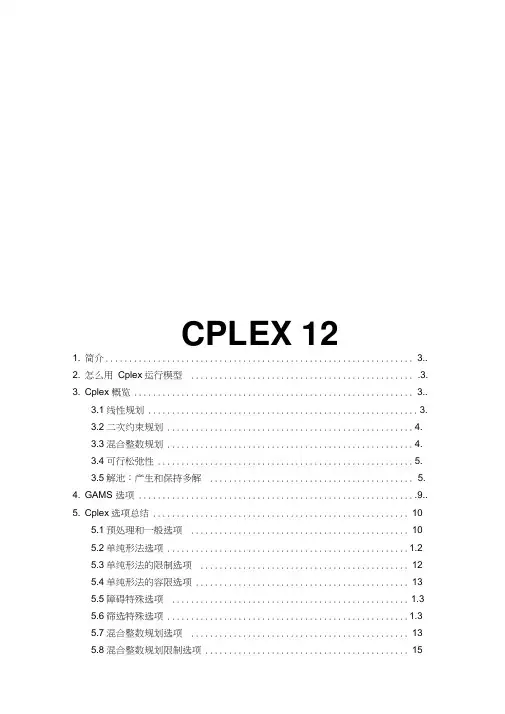
CPLEX 121. 简介................................................................. 3..2. 怎么用Cplex运行模型 (3)3. Cplex 概览........................................................... 3..3.1线性规划......................................................... 3.3.2二次约束规划....................................................4.3.3混合整数规划....................................................4.3.4可行松弛性...................................................... 5.3.5解池:产生和保持多解........................................... 5.4. GAMS 选项.......................................................... .9..5. Cplex选项总结 (10)5.1预处理和一般选项 (10)5.2单纯形法选项................................................... 1.25.3单纯形法的限制选项 (12)5.4单纯形法的容限选项 (13)5.5障碍特殊选项.................................................. 1.35.6筛选特殊选项................................................... 1.35.7混合整数规划选项 (13)5.8混合整数规划限制选项 (15)5.9混合整数规划解池选项 (16)5.10混合整数规划容许度选项....................................... 1.65.11输出选项...................................................... 1.75.12 GAMS/Cplex选项文件......................................... 1.76. 特殊备注 (18)6.1物理内存限制................................................... 1.86.2使用特殊有序集 (18)6.3使用半连续半整数变量 (19)6.4为求解MIP问题耗尽内存 (19)6.5不能证明整数最优 (20)6.6从混合整数规划的解开始 (20)6.7使用可行松弛性 (21)7. GAMS/ CPLE)日志文件 (22)8. CPLEX选项的详细说明 (25)1.简介GAMS/Cplex是一种用于GAMS (The General Algebraic Modeling System通用代数建模系统)的求解器,它使得用户可以把GAMS(通用代数建模系统的)的高级建模功能跟Cplex优化器的优势结合起来。



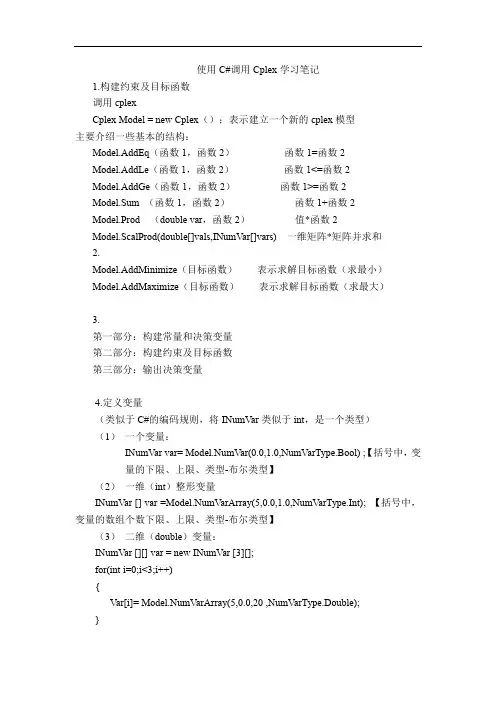
使用C#调用Cplex学习笔记1.构建约束及目标函数调用cplexCplex Model = new Cplex();表示建立一个新的cplex模型主要介绍一些基本的结构:Model.AddEq(函数1,函数2)函数1=函数2Model.AddLe(函数1,函数2)函数1<=函数2Model.AddGe(函数1,函数2)函数1>=函数2Model.Sum (函数1,函数2)函数1+函数2Model.Prod (double var,函数2)值*函数2Model.ScalProd(double[]vals,INumVar[]vars) 一维矩阵*矩阵并求和2.Model.AddMinimize(目标函数)表示求解目标函数(求最小)Model.AddMaximize(目标函数)表示求解目标函数(求最大)3.第一部分:构建常量和决策变量第二部分:构建约束及目标函数第三部分:输出决策变量4.定义变量(类似于C#的编码规则,将INumVar类似于int,是一个类型)(1)一个变量:INumVar var= Model.NumVar(0.0,1.0,NumVarType.Bool) ;【括号中,变量的下限、上限、类型-布尔类型】(2)一维(int)整形变量INumVar [] var =Model.NumVarArray(5,0.0,1.0,NumVarType.Int); 【括号中,变量的数组个数下限、上限、类型-布尔类型】(3)二维(double)变量:INumVar [][] var = new INumVar [3][];for(int i=0;i<3;i++){Var[i]= Model.NumVarArray(5,0.0,20 ,NumVarType.Double);}(4)三维0,1决策变量:INumVar[][][] XIJK = new INumVar[4][][];for (int i = 0; i < 4; i++){XIJK[i] = new INumVar[5][];for (int j = 0; j < 5; j++){XIJK[i][j]=Model.NumVarArray(7,0.0,1.0,NumVarType.Bool);}}一些小方法:1.Model.NumVarArray(int n, double lb, double ub, NumVarType type);//添加决策变量括号中的四项依次是个数,下界,上界,变量类型比如:C = Model.NumVarArray(NumberOfJobs + 2, 0.0, System.Double.MaxValue, NumVarType.Float); 浮点型变量--连续类型B=Model.NumVarArray(NumberOfMachines, 0.0, 1.0, NumVarType.Bool);布尔型变量还有NumVarType.Int 整数型--离散类型2. Model.NumVar(0.0, System.Double.MaxValue, NumVarType.Float);//括号中的三项依次是下界,上界,变量类型3.Model.Prod(1.0, X) 1*x 数相乘Model.ScalProd(x, y) 相当于,矩阵x每点和y对应点每点相乘后相加。
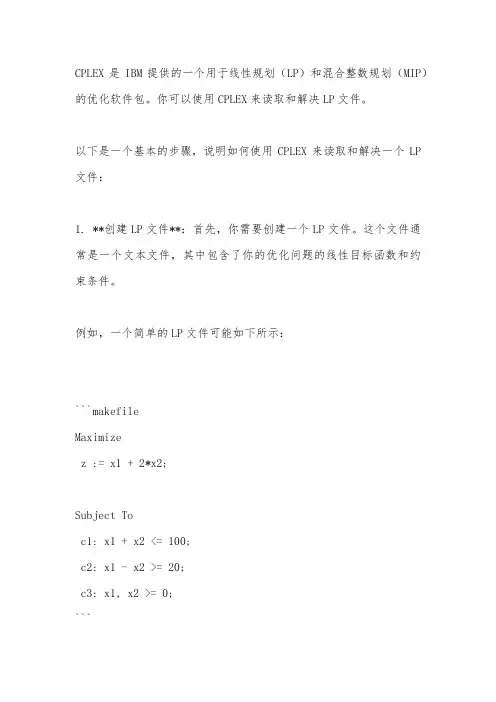
CPLEX是IBM提供的一个用于线性规划(LP)和混合整数规划(MIP)的优化软件包。
你可以使用CPLEX来读取和解决LP文件。
以下是一个基本的步骤,说明如何使用CPLEX来读取和解决一个LP 文件:1. **创建LP文件**:首先,你需要创建一个LP文件。
这个文件通常是一个文本文件,其中包含了你的优化问题的线性目标函数和约束条件。
例如,一个简单的LP文件可能如下所示:```makefileMaximizez := x1 + 2*x2;Subject Toc1: x1 + x2 <= 100;c2: x1 - x2 >= 20;c3: x1, x2 >= 0;```在这个例子中,我们试图最大化目标函数`z := x1 + 2*x2`,同时满足三个约束条件。
2. **使用CPLEX读取和解决LP文件**:你可以使用CPLEX的命令行界面来读取和解决这个LP文件。
以下是一个基本的例子:```bashcplexlp -f your_lp_file.lp -solve -display -out lp_solution.txt```在这个命令中:* `-f your_lp_file.lp` 指定了你的LP文件的路径。
* `-solve` 告诉CPLEX要解决这个问题。
* `-display` 会显示解决方案的详细信息。
* `-out lp_solution.txt` 将解决方案输出到一个文本文件中。
3. **查看解决方案**:一旦你运行了上述命令,CPLEX就会读取你的LP文件,并输出一个解决方案到`lp_solution.txt`文件中。
你可以打开这个文件来查看解决方案。
请注意,上述步骤假设你已经安装了CPLEX,并且可以在命令行环境中运行CPLEX命令。
如果你使用的是其他环境(例如,Python或Java的CPLEX API),那么步骤可能会有所不同。
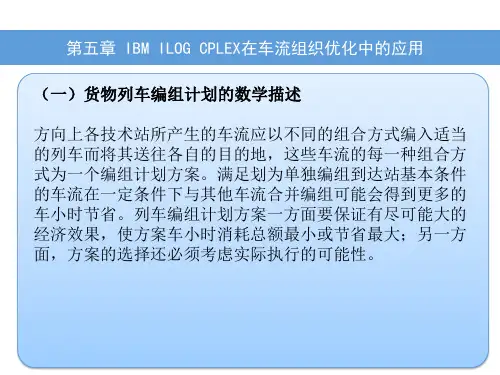
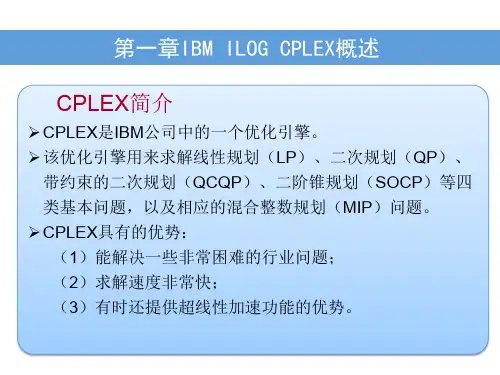
java cplex调用示例如何在Java中使用CPLEX进行求解使用IBM CPLEX是一种常见的求解线性规划和整数规划问题的方法。
CPLEX是一种高效的数学优化库,它提供了多种求解算法和优化策略。
在本文中,我将带你一步一步了解如何在Java中使用CPLEX进行求解,并提供一些示例代码。
1. 安装CPLEX库首先,你需要将CPLEX库安装到你的计算机上。
CPLEX可以从IBM官网上下载,并根据相应的操作系统进行安装。
安装完成后,你将获得一个包含CPLEX 库文件的文件夹。
2. 配置Java项目在Java项目中使用CPLEX之前,你需要配置相应的构建路径。
这可以通过在Eclipse或IntelliJ等集成开发环境中导入CPLEX库来完成。
你可以选择将CPLEX 库文件直接复制到项目的lib文件夹中,或者通过修改项目的构建路径来引用库文件。
完成后,你可以开始在Java代码中使用CPLEX库。
3. 导入CPLEX库在Java代码文件的顶部,你需要导入CPLEX库。
这可以通过使用Java的import 语句来完成。
例如,在使用CPLEX的线性规划功能之前,你需要导入IloCplex 类。
导入语句如下:javaimport ilog.concert.*;import ilog.cplex.*;4. 创建求解器在使用CPLEX进行求解之前,你需要创建一个求解器对象。
这个对象将提供CPLEX求解算法的接口,并负责加载问题和求解。
你可以使用IloCplex类来创建一个求解器对象。
示例代码如下:javaIloCplex cplex = new IloCplex();5. 定义决策变量在使用CPLEX求解问题之前,你需要定义问题的决策变量。
CPLEX使用IloNumVar类表示决策变量。
你需要指定决策变量的类型、上下界和名称。
示例代码如下:javaint numVars = 3;double[] lb = {0.0, 0.0, 0.0};double[] ub = {40.0, 3.0, Double.MAX_VALUE};IloNumVar[] x = cplex.numVarArray(numVars, lb, ub);在上面的示例中,我们定义了3个决策变量,它们的下界分别为0.0、0.0和0.0,上界分别为40.0、3.0和无穷大。
python调用cplex模型语法Python调用Cplex模型语法指的是使用Python编程语言来调用Cplex优化软件的模型语言进行数学建模和求解。
Cplex是一个非常受欢迎的商业数学优化软件,可以用于线性规划、整数规划、混合整数规划、二次规划等优化问题。
Python是一种通用的编程语言,在科学计算和数据分析方面非常流行。
使用Python调用Cplex模型语法可以实现快速构建优化模型、灵活的数据处理、多种求解算法、可视化结果等功能。
下面是Python 调用Cplex模型语法的一些基本语法和示例:1. 导入Cplex模块```pythonimport cplex```2. 创建Cplex求解器对象```pythonsolver = cplex.Cplex()```3. 创建变量```pythonsolver.variables.add(names=['x', 'y'], lb=[0.0, 0.0], ub=[1.0, cplex.infinity])```4. 添加目标函数```pythonsolver.objective.set_sense(solver.objective.sense.maximize) solver.objective.set_linear([('x', 1.0), ('y', 2.0)]) ```5. 添加约束条件```pythonsolver.linear_constraints.add(lin_expr=[cplex.SparsePair(in d=['x', 'y'], val=[1.0, 1.0])], senses=['L'], rhs=[1.0])```6. 求解模型```pythonsolver.solve()```7. 输出结果```pythonprint('Obj:', solver.solution.get_objective_value())print('x=', solver.solution.get_values('x'))print('y=', solver.solution.get_values('y'))```以上是一个简单的线性规划模型,如果要解决更复杂的问题,需要更多的语法和技能。
CPLEX 12目录1. 简介 (3)2. 怎么用Cplex运行模型 (3)3. Cplex概览 (3)3.1线性规划 (3)3.2二次约束规划 (4)3.3混合整数规划 (4)3.4 可行松弛性 (5)3.5 解池:产生和保持多解 (5)4. GAMS选项 (9)5. Cplex选项总结 (10)5.1 预处理和一般选项 (10)5.2 单纯形法选项 (12)5.3 单纯形法的限制选项 (12)5.4 单纯形法的容限选项 (13)5.5 障碍特殊选项 (13)5.6 筛选特殊选项 (13)5.7 混合整数规划选项 (13)5.8 混合整数规划限制选项 (15)5.9 混合整数规划解池选项 (16)5.10 混合整数规划容许度选项 (16)5.11输出选项 (17)5.12 GAMS/Cplex选项文件 (17)6. 特殊备注 (18)6.1 物理内存限制 (18)6.2 使用特殊有序集 (18)6.3 使用半连续半整数变量 (19)6.4为求解MIP问题耗尽内存 (19)6.5 不能证明整数最优 (20)6.6 从混合整数规划的解开始 (20)6.7 使用可行松弛性 (21)7. GAMS/ CPLEX日志文件 (22)8. CPLEX选项的详细说明 (25)GAMS/Cplex是一种用于GAMS (The General Algebraic Modeling System,通用代数建模系统)的求解器,它使得用户可以把GAMS(通用代数建模系统的)的高级建模功能跟Cplex优化器的优势结合起来。
Cplex优化器是为能快速、最少用户干预地解决大型、复杂问题而设计的。
求解线性、二次约束和混合整数规划问题的Cplex算法现在已提供访问(针对恰当的许可证)。
尽管现存有多种求解工具,但是,GAMS/Cplex能自动地为特定问题计算最优值和设置大部分选项。
本文接下来总结了GAMS/Cplex的所有Cplex选项。
cplex建模语句CPLEX是一个用于数学优化的软件工具,它提供了一种建模语言来描述优化问题。
建模语句通常包括变量定义、约束条件和目标函数。
下面我将从多个角度来介绍如何使用CPLEX进行建模语句的编写。
首先,我们来看看变量定义。
在CPLEX中,可以使用以下语句来定义变量:dvar float+ x; // 定义一个非负实数型变量x.dvar int x; // 定义一个整数型变量x.这些语句用于定义决策变量,并且可以指定变量的类型和范围。
其次,约束条件在建模语句中也起着重要作用。
在CPLEX中,可以使用以下语句来定义约束条件:subject to Constraint1: 2x + 3y <= 10; // 定义一个线性约束条件。
subject to Constraint2: x + y >= 5; // 定义另一个线性约束条件。
这些语句用于描述问题中的约束条件,可以是线性的也可以是非线性的,可以包含等式和不等式约束。
最后,目标函数也是建模语句中不可或缺的一部分。
在CPLEX 中,可以使用以下语句来定义目标函数:maximize Objective: 3x + 2y; // 定义一个最大化目标函数。
minimize Objective: 4x 2y; // 定义一个最小化目标函数。
这些语句用于描述优化问题的目标,可以是最大化或最小化目标函数。
综上所述,CPLEX建模语句的编写涉及到变量定义、约束条件和目标函数的描述。
通过合理的建模语句,可以有效地描述和求解各种数学优化问题。
希望以上介绍能够帮助你更好地理解CPLEX建模语句的编写。